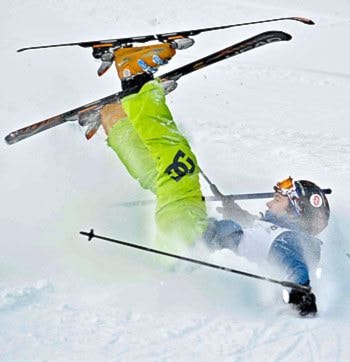The recent death of freestyle skier Sarah Burke was a stark reminder of the dangers associated with winter sports.
Of course, few people are performing 1080s on a superpipe, but downhill activities are one of the main causes for hospital stays, according to data released last week from the Canadian Institute for Health Information.
Last winter, skiing and snowboarding accounted for 2,329 hospital visits, for one night or longer, in Canada. That’s twice as many as hockey with 1,114. Other activities listed in the study include snowmobiling with 1,126, ice skating with 889 and tobogganing with 171.
“There is a lot to enjoy about Canadian winters, but safety and precautions are important across all age groups,” said Greg Webster, director of primary health-care information and clinical registries at the institute, in a media release.
“Every year, more than 5,000 Canadians get seriously injured—requiring at least one night’s hospital stay—due to a winter sport or recreational activity,” Webster said. “These numbers do not include visits that involve only the emergency department or a doctor’s office or deaths at the scene, so the total number of injuries is actually much higher.”
But does that mean the slopes are more dangerous than hockey rinks? Not necessarily.
What the study fails to record is the number of Canadians participating in the various activities. Therefore, if twice as many people ski and snowboard than play hockey in Canada, then the two activities have similar rates of injury.
Though injury rates between activities may be difficult to pinpoint, rates for ages and between genders are more defined.
About half of hockey injuries and a third of downhill injuries involved people between 10 to 19. Of those, 81 per cent were male.
Snowmobiling was an anomaly in the study when it came to age. The vast majority of snowmobile injuries - 752 of 1,126 - involved adults 20-49.
Although the Canadian Standards Association reports skiing and snowboarding injuries grew by about a quarter between 2004 and 2009, the study’s finding says the rate of head injuries from the two sports over the past five years has remained about the same. Last year 135 head injuries from skiing and snowboarding were reported. That’s roughly 18 per cent of the 759 from the last five years.
“When it comes to winter, it’s important that Canadians get outside to play and enjoy our slopes,” said Dr. Natalie Yanchar, associate professor of Surgery and Emergency Medicine at Dalhousie University and Medical Director at IWK Trauma Care in Halifax, in the release.
“Wearing a helmet is important for all ages to prevent a fun day in the snow from ending in tragedy. Without question, it reduces the risk of serious head injuries in case of a crash.”
Staying off the slopes, ice rink, snowmobiles and toboggans does not remove the dangers involved with snow and ice. The sidewalk can be just as dangerous, according to the study.
Excluding motor vehicle collisions, falls on ice were the most common cause of hospital visits in winter, accounting for 7,138 in the 2010/11 season. Roughly half of those cases involved people 60 and older while 70 per cent involved people 50 and older.
Women accounted for 56 per cent of those hospitalized from falls on ice.
Contact Tom Patrick at
tomp@yukon-news.com
